One day there was a boy who felt so much guilt that he prayed to the heavens for punishment. Suddenly the log he sat upon fused with his body leaving him prone and exposed which he endured in stoic silence until his death. This was The First Miracle around which the theocracy Cvstodia would build itself. Centuries later, the Miracle still affects Cvstodia’s people, answering sincere expressions of faith with spiteful and ironic afflictions. It spares three sisters from unwanted arranged marriages by transforming them into a hairy three-faced monster. It stops the suffering of torture victims by visiting all their wounds on the witness who prayed for mercy. But while the Miracle is capricious, the heads of Cvstodia’s church have become bloodthirsty and dictatorial. They order the elite warriors of the Brotherhood of the Silent Sorrow, the last threat to their power, exterminated. Only one survives, The Penitent One, who sets out into Cvstodia to bring down the cruel Church and put an end to the Age of Corruption.
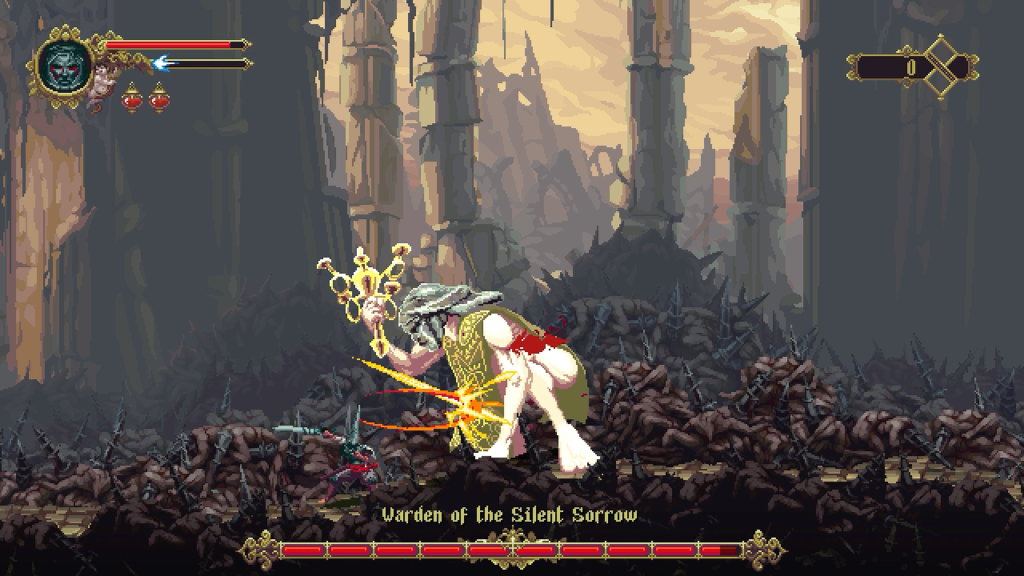
In Blasphemous, I take control of The Penitent One and guide them on a quest to defeat the leaders of the corrupt church. They are armed with an ornate sword called Mea Culpa which they use to counter enemy attacks, or else dodge through them to attack their vulnerable backsides. The Mea Culpa’s hilt is affixed with a vicious thorn that cuts into The Penitent One’s hands with every swing. The accumulated blood from these wounds powers The Penitent One’s Fervour, a resource that unleashes powerful magic and prayers that damage enemies or further empower the hero. The Penitent One also accumulates their own tears with every kill which can be used to purchase new combat abilities.
If it’s not clear by now, with its obsession with bodily pain, fixation on guilt, and worship of saints who suffered ironic fates, Blasphemous is a very Catholic game.
Much though it annoys me to make the comparison, it’s impossible to deny the influence Dark Souls has on Blasphemous’s combat. Enemies at first seem powerful, maybe even insurmountable, but learning their patterns and when to dodge or parry turns them into minor playthings. If The Penitent One is injured, I can heal them by using a bloody potion that takes a moment to apply; this potion’s charges are limited but refilled at save points and expanded as I explore Cvstodia. If I get The Penitent One killed, they leave behind an echo of Guilt that reduces their maximum Health and Fervour until I reclaim the echo.
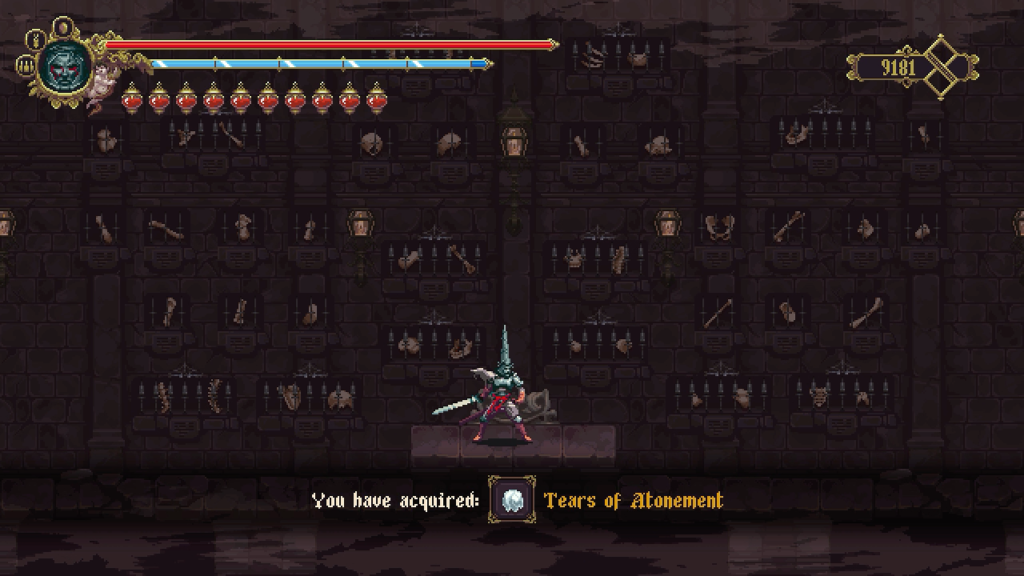
Dark Souls’ influence is also felt in the collectibles. The Penitent One finds dozens of artifacts on their quest, some functional but most describing Cvstodia’s lore if I take the time to read their flavor text. If I want to have a complete understanding why the Convent of Our Lady of the Charred Visage is filled with fiery traps or how Expósito, Scion of Abjuration came to be a blinded baby embraced by a wicker giant, I must track down their related artifacts and take the time to comprehend how they fit together. None of this is necessary to complete or enjoy Blasphemous, but none of Cvstodia’s terrible sights are inexplicable, and puzzling together these histories adds richness and texture to the world.
Despite borrowing so many of Dark Souls’ mechanics, Blasphemous takes a surprising departure in difficulty. I don’t mean to suggest it’s easy, but The Penitent One can take quite a few hits before dying and dispatches their opponents with proportionate ease. Better still, the timing windows for parrying or dodging enemy attacks are quite wide; if I’m sluggish or distracted, it won’t prove fatal to The Penitent One. Blasphemous feels deliberately influenced by Dark Souls, but it defies Souls’ reputation for punishing difficulty.
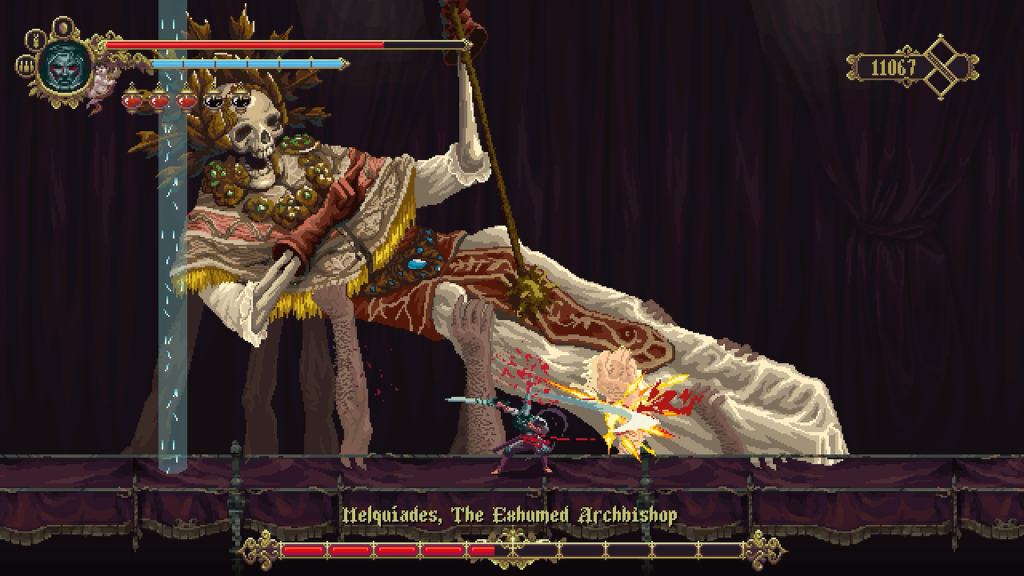
This doesn’t mean Blasphemous’s combat never challenged me. The Penitent One’s quest is signposted by epic battles with the Church’s leaders, each transformed by the Miracle into towering grotesques who test all my skill. Memorable encounters include Our Lady of the Charred Visage, a massive burned face that bombards The Penitent One with flames in an intense bullet hell challenge; Melquíades, The Exhumed Archbishop, a pristine skeleton held aloft by the adoring hands of its worshipers; and Quirce, Returned By The Flames, a perpetually-immolated man who ricochets around the battlefield like a cannonball. I’ve often felt that the Souls series made its incidental battles more difficult than its bosses and Blasphemous feels like a welcome re-righting to a boss’ proper place at the top of the heap.
All this swordplay and artifact hunting in Cvstodia is navigated as a side-scrolling platformer in a persistent open world. By exploring this world’s furthest reaches, I can uncover special items which grant The Penitent One unique movement abilities to bypass obstacles such as pits and rooms flooded with choking gas. These new abilities lead to still more, each unlocked in turn until The Penitent One has command over the entire map.
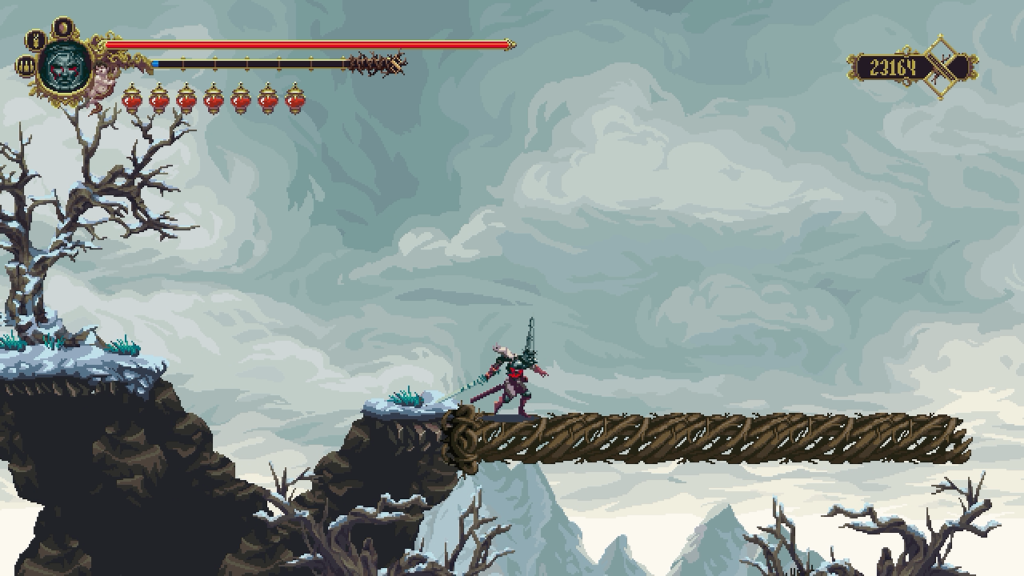
These systems are familiar in open-world platformers but it’s difficult to be annoyed by their application here. They’re used so often because they work so well. Blasphemous does stretch itself in how these abilities function, but I won’t describe them because I want players to be as surprised as I am. Less impressive is the restrictions put on these abilities. The Penitent One is allowed to equip no more than three at a time for no apparent reason, and on many occasions I send them plunging down a deadly pit because I forget to switch powerups before the leap.
In fact, my deaths in bottomless and spike-lined pits far outnumbered those felt at the Church’s agents due to Blasphemous’ biggest problem: imprecise platforming. The Penitent One’s last chance to jump comes far sooner than in other platformers, and being accustomed to those videogames I often found myself pressing jump long after the window had closed. There’s a similar problem with jumping to suspended ladders, my frustration mounting as I feel like I’m telling The Penitent One to grab a ladder in midair and they ignore those commands, impaling themself on the spikes below. Do-or-die platforming is not Blasphemous’ focus, but the few rooms which emphasize precise leaps and fatal traps proved far greater obstacles than Cvstodia’s deadliest denizens.
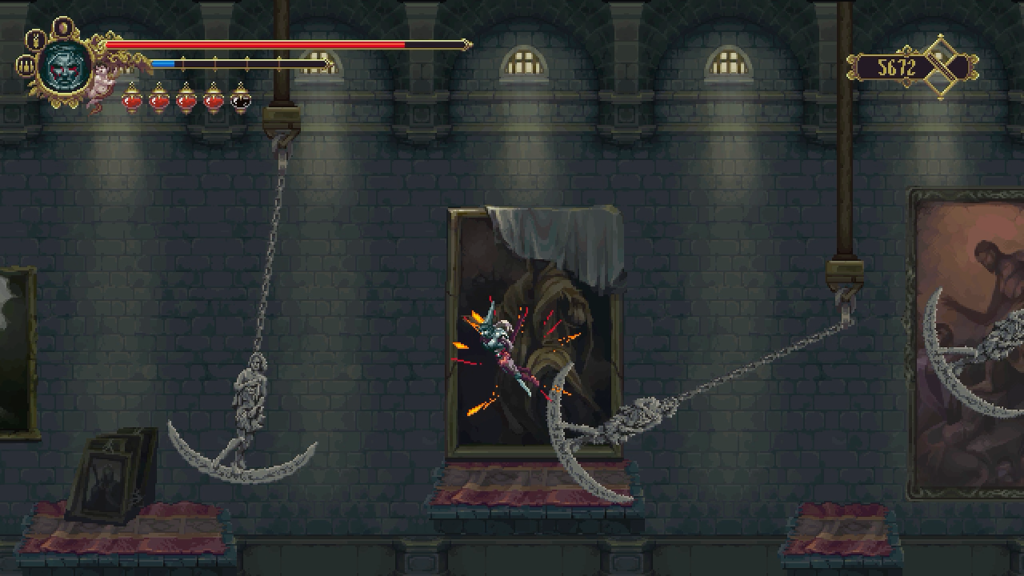
While Blasphemous imitates classic platformers with varying degrees of success, its smartest innovation is almost imperceptible. In another adventure-platformer, I expect to see certain areas of the world just out of my player character’s reach. I don’t let this bother me as I know I will gain access to a double jump that will let me reach those just-too-far cliffs. Blasphemous not only eschews a double jump but makes all movement abilities optional.
At the start of The Penitent One’s quest they must first carry out three Humiliations before they can enter the Church’s innermost depths. These Humiliations are, of course, boss fights. I can confront these perils in any order I choose and without once double-jumping, flash-stepping, gliding, or any other powers familiar to the genre. And when I defeat the three Humiliations and open the door to the Church’s inner cloister, I find another seal which can only be broken with the deaths of three more bosses. Once again, no magical acrobatics are needed to find and kill them, and I may challenge them in any order I wish.
Finding The Penitent One’s movement abilities helps to fully kit them with health and combat upgrades, so I ignore them at my peril, but it’s still an interesting heresy from design dogma. It feels like the idea may be to streamline minimum percentage runs endemic to the genre; there’s no need to master wall collision shenanigans or double-jumping exploits because they’re not needed in the first place, putting less-experienced players on more even footing with speedrunning pros.

It’s disappointing, perhaps even eye-rolling, that Blasphemous is so derivative of Dark Souls and Metroid. It could easily find itself lost amid the dozens of indie imitators who draw their inspiration from those influential classics. But it finds ways to make itself feel distinct amid the crowd. Cvstodia is gorgeous, capturing the horror of Christian religious fanaticism in intricate and bloody gothic pixel art. It sets a good balance between difficult enemies and grueling boss battles. Best of all, it explores with some success new ideas of how an adventure-platformer’s world may be traversed and explored, striving to have more original ideas than double jumping and putting no color-coded barriers between The Penitent One and their goals. Blasphemous trusts me to plot my own course in ending the Age of Corruption, making a visit to Cvstodia an enjoyable one.